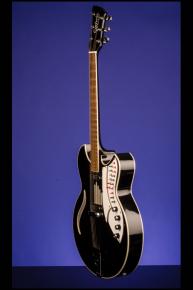An All Original Mid-Seventies Guitar Organ.
1976 Godwin Guitar Organ (16/4).
This super rare double florentine cutaway hollow body Guitar Organ weighs 9.70 lbs. Maple top with a single-bound 'S' shaped sound-hole and five single-bound slotted sound-holes of varying lengths, all with silver mesh. Maple back with large removable panel secured by ten screws. Maple sides. The top and bottom of the body is triple bound. The width of the guitar is 16 1/4 inches, the body length is 20 1/2 inches and the body depth is 2 7/8 inches. Three-piece maple neck with a nut width of just over 1 5/8 inches, a scale length of 24 3/4 inches and a thick profile. Specific shaped headstock with "Godwin / Organ" inlaid in white. Individual Grover 'Rotomatic' tuners with half-moon shaped metal buttons. Single-bound rosewood fretboard with 21 original thin frets and black dot side markers. Each fret is divided into six segments, to sense individual string contact. Four-bolt neck-plate engraved "Made in Italy / 10097". Two single-coil pickups which give normal guitar sounds independent of the 'Organ' section. Four rotary controls and sixteen mini toggle switches. Black plastic control knobs with ribbed sides and metal tops, mini-switches with multi-color plastic tips. Specific bridge with six individually adjustable threaded saddles on height adjustable black base. Specific trapeze style "G" cutout tailpiece secured by three screws. Complete with the original volume control pedal/transformer with 115v cable, specific five-pin jack for connection to guitar and stereo cable for connection from pedal to two amplifier inputs. This GuitarOrgan is in remarkably fine (9.00) condition. Housed in the original three latch rectangular black hardshell case with pale orange plush lining (9.00).
Very few of these instruments were made during just one year in 1976 - just before the miniaturization of electronic chips - hence the necessity for the large, deep body.
The four rotary controls are "Guitar Volume", "Guitar Balance", "Organ Volume" & "Organ Sustain". The sixteen mini-toggle switches (for the organ) include Microphone, Electric, Sustain, Percussion, Vibrato on, Vibrato fast, Tone, Flute, Strings, Trumpet, Oboe, Strings, Flute and others.
"it was in the 1960s that special effects and gimmicky sounds for the electric guitar first became available. These came via separate foot-operated pedals offering tone-boosts, distortion, "wah-wah," and so on. Some makers chose to build effects into the guitar itself, and the more comprehensively equipped versions of these instruments can be considered the forerunners of the guitar synthesizer. Unfortunately the amount of wood removed from the bodies of these guitars to make way for the extra electronics adversely affected their natural sustain and tone. Also, while the additional circuitry certainly made the fashionably funny noises, it was invariably at the expense of decent, normal guitar sounds. For years makers had been trying to produce a guitar that sounded like an organ. The Italian Godwin 'GuitarOrgan' from 1976 used the Vox method, in which the frets are wired to a set of organ tone generators. A string touching a fret completes a circuit and produces the relevant organ note. The Godwin had a huge array of knobs and switches giving organ pipe sounds and electronic effects. This relatively heavy guitar does manage to impersonate a church organ." (Tony Bacon. The Ultimate Guitar Book, pp. 182-183 with color illustration).
"In 1976 and Italian company known as Sisme which produced Godwin Organs came up with a product they called The Organ. As we may discussed with the Wandre guitar, Italian made guitars seem to possess an accordion-like quality. They all seem to have sparkly designs, use of celluloid coverings and lots of buttons. The Godwin (guitar) Organ was no exception. It certainly looked impressive since the controls covered the entire bottom side of the instrument. Users claim it produces a sound similar to a Hammond organ, especially if fed into a Leslie rotary speaker. Like the Hammonds drawbars, which emphasize different overtones produced by the tonewheels that produce the percussive like sound. The Goodwin Guitar-Organ utilizes rotary knobs for this purpose. The instrument also has had slow/fast vibrato with an on/off switch so that even without the Leslie, you can get a pretty good impression. The Godwin Guitar-Organ has 19 switches and 13 knobs. They also produced a lower cost model with 16 switches and 4 knobs."

















